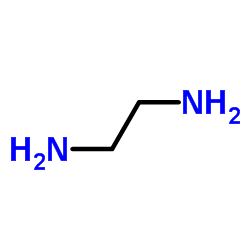Pixantrone

Pixantrone structure
|
Common Name | Pixantrone | ||
|---|---|---|---|---|
| CAS Number | 144510-96-3 | Molecular Weight | 325.365 | |
| Density | 1.4±0.1 g/cm3 | Boiling Point | 650.0±55.0 °C at 760 mmHg | |
| Molecular Formula | C17H19N5O2 | Melting Point | N/A | |
| MSDS | N/A | Flash Point | 346.9±31.5 °C | |
Use of PixantronePixantrone is a topoisomerase II inhibitor and DNA intercalator, with anti-tumor activity. |
| Name | 6,9-bis(2-aminoethylamino)benzo[g]isoquinoline-5,10-dione |
|---|---|
| Synonym | More Synonyms |
| Description | Pixantrone is a topoisomerase II inhibitor and DNA intercalator, with anti-tumor activity. |
|---|---|
| Related Catalog | |
| Target |
Topoisomerase II |
| In Vitro | Pixantrone is a topoisomerase II inhibitor. Pixantrone induces cell death in multiple cancer cell lines independent of cell cycle perturbation, with IC50s of 37.3 nM, 126 nM and 136 nM for T47D, MCF-10A and OVCAR5 cells, respectively. Pixantrone induces DNA damage at high concentrations (500 nM) but not at concentrations (100 nM) sufficient to kill PANC1 cells. Pixantrone (25 or 100 nM) induces severe chromosomal aberrations and mitotic catastrophe in PANC1 cells. Pixantrone (100 nM) may disrupt chromosome segregation because of generating merotelic kinetochore attachments that cause chromosome non-disjunction[1]. Pixantrone potently inhibits growth of human Leukemia K562 cells, etoposide-resistant K/VP.5 cells, MDCK and ABCB1-transfected MDCK/MDR cells, with IC50s of 0.10 μM, 0.56 μM, 0.058 μM and 4.5 μM, respectively. Pixantrone (0.01-0.2 μM) leads to a concentration-dependent formation of linear DNA through acting on topoisomerase IIα. Pixantrone produces semiquinone free radicals in an enzymatic reducing system, although not in a cellular system, most likely due to low cellular uptake[2]. Pixantrone (0.01-10 μM) shows potent inhibitory activities against rat 97-116 peptide-specific T cell proliferation[4]. |
| In Vivo | Pixantrone (27 mg/kg) does not worsen pre-existing moderate degenerative cardiomyopathy in doxorubicin-pretreated mice, by i.v. one dose every 7 days repeated thrice (q7d × 3). Pixantrone (27 mg/kg) causes minimal cardiotoxic in mice following repeated treatment cycles. Moreover, Pixantrone results in less mortality than mitoxantrone in doxorubicin-pretreated mice[3]. Pixantrone (16.25 mg/kg i.v, q7d × 3) modulates Lymph node cells (LNC) responses, and affacts T cell subpopulations in TAChR-immunized Lewis rats. Pixantrone also shows preventive and therapeutic effect in experimental autoimmune myasthenia gravis (EAMG) rats[4]. |
| Cell Assay | Briefly, cells seeded into 96-well plates are treated with increasing concentrations of either pixantrone or doxorubicin for 72 hours. After this time, MTS reagent is added to cells and incubated at 37°C for a further 4 hours. Cell proliferation is then determined by measuring the absorbance at 490 nm. All data points are normalized to untreated cells. All treatments are performed in triplicate and performed a minimum of 3 times[1]. |
| Animal Admin | Mice[3] To evaluate the potential cardiotoxicity of Pixantrone in doxorubicin-pretreated mice, doxorubicin 7.5 mg/kg is administered intravenously every 7 days for 3 weeks (1 cycle) to a group of CD1 females. Six weeks later, these mice receive either 0.9% saline (vehicle), doxorubicin 7.5 mg/kg, Pixantrone 27 mg/kg, or mitoxantrone 3 mg/kg intravenously every 7 days for 3 weeks (2 cycles). Animals are sacrificed after the first cycle at 8 weeks, and after the second cycle at 16 weeks. In addition, to evaluate the potential cardiotoxicity of Pixantrone as a single agent compared with doxorubicin and mitoxantrone, CD1 female mice receive a single or a double cycle of vehicle, doxorubicin 7.5 mg/kg, Pixantrone 27 mg/kg, or mitoxantrone 3 mg/kg. These animals are sacrificed after the first and second cycles (at 8 and 16 weeks, all groups), during week 14 (Pixantrone-treated group only) and during week 22 (Pixantrone- and vehicle-treated groups)[3]. Rats[4] For the studies on Pixantrone efficacy on EAMG, TAChR-immunized rats are randomly assigned to different treatment groups: 1) preventive Pixantrone group, starting 4 days after immunization, with 16.25 mg/kg Pixantrone, administered i.v. via tail vein, once a week for three times; 2) therapeutic Pixantrone group, starting 4 wk after immunization, with 16.25 mg/kg Pixantrone, administered i.v. via tail vein, once a week for three times; 3) therapeutic MTX group (1.2 mg/kg, i.v. via tail vein, once a week for three times); and 4) vehicle group (sterile saline, i.v. via tail vein, once a week for three times). The doses of Pixantrone and MTX used in this study are in both cases equal to one-fourth of the LD10 for single i.v. injection in rats. Treatment assignation is performed at day 4 after TAChR immunization (preventive schedule) in coincidence of the acute phase of EAMG, or at onset of clinical signs (therapeutic schedule), which occurs after 4 wk. Animals are sacrificed after deep anesthesia obtained by carbon dioxide; low-grade anesthesia with chloral hydrate administered i.p. is used for TAChR immunization and drug treatments[4]. |
| References |
| Density | 1.4±0.1 g/cm3 |
|---|---|
| Boiling Point | 650.0±55.0 °C at 760 mmHg |
| Molecular Formula | C17H19N5O2 |
| Molecular Weight | 325.365 |
| Flash Point | 346.9±31.5 °C |
| Exact Mass | 325.153870 |
| PSA | 123.13000 |
| LogP | -1.13 |
| Vapour Pressure | 0.0±1.9 mmHg at 25°C |
| Index of Refraction | 1.729 |
| Storage condition | 2-8℃ |
|
~% 
Pixantrone CAS#:144510-96-3 |
| Literature: Journal of Medicinal Chemistry, , vol. 37, # 6 p. 828 - 837 |
|
~% 
Pixantrone CAS#:144510-96-3 |
| Literature: Journal of Medicinal Chemistry, , vol. 37, # 6 p. 828 - 837 |
|
~% 
Pixantrone CAS#:144510-96-3 |
| Literature: Journal of Medicinal Chemistry, , vol. 37, # 6 p. 828 - 837 |
|
~% 
Pixantrone CAS#:144510-96-3 |
| Literature: Journal of Medicinal Chemistry, , vol. 37, # 6 p. 828 - 837 |
| Benz[g]isoquinoline-5,10-dione, 6,9-bis[(2-aminoethyl)amino]- |
| 6,9-bis<(2-aminoethyl)amino>benzo<g>isoquinoline-5,10-dione |
| 6,9-Bis[(2-aminoethyl)amino]benz[g]isoquinoline-5,10-dione |
| Pixantrone |
| 6,9-Bis((2-aminoethyl)amino)benzo(g)isoquinoline-5,10-dione |
| 6,9-Bis[(2-aminoethyl)amino]benzo[g]isoquinoline-5,10-dione |
| Pixuvri (TN) |
| 6,9-Bis((2-aminoethyl)amino)benz(g)isoquinoline-5,10-dione |
| 5,8-Bis((2-aminoethyl)amino)-2-aza-anthracene-9,10-dione |
| Benz(g)isoquinoline-5,10-dione, 6,9-bis((2-aminoethyl)amino)- |
| 6,9-Aea-biqdo |
![Furo[3,4-c]pyridine-1,3-dione structure](https://image.chemsrc.com/caspic/268/4664-08-8.png)

![6,9-Dihydroxybenzo[g]isoquinoline-5,10-dione structure](https://image.chemsrc.com/caspic/455/4589-37-1.png)

![6,9-Difluorobenzo[g]isoquinoline-5,10-dione structure](https://image.chemsrc.com/caspic/109/144511-13-7.png)